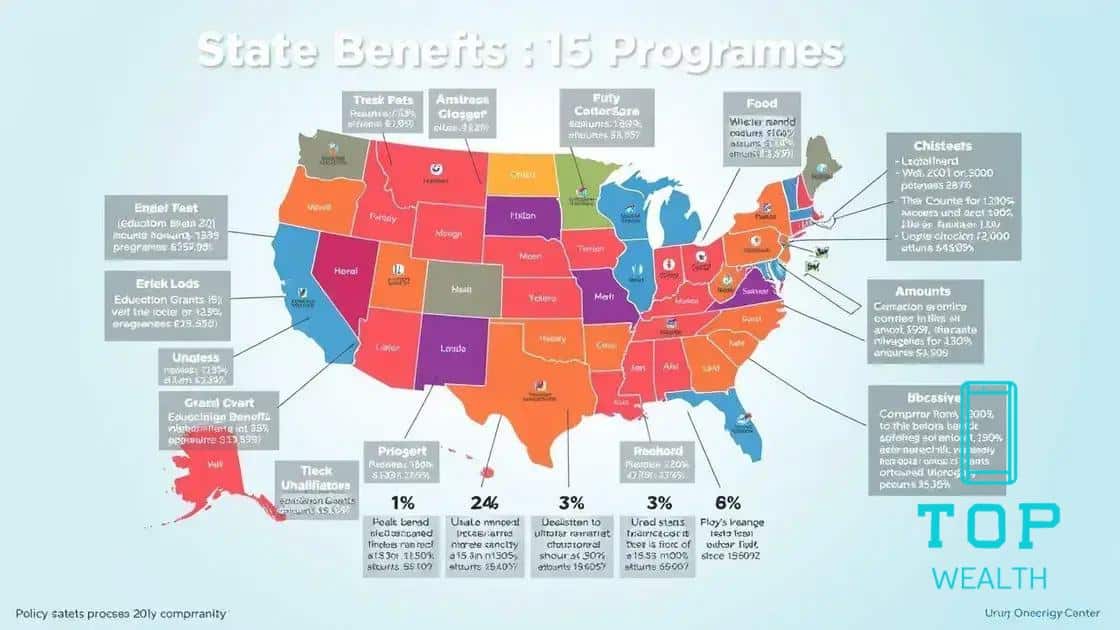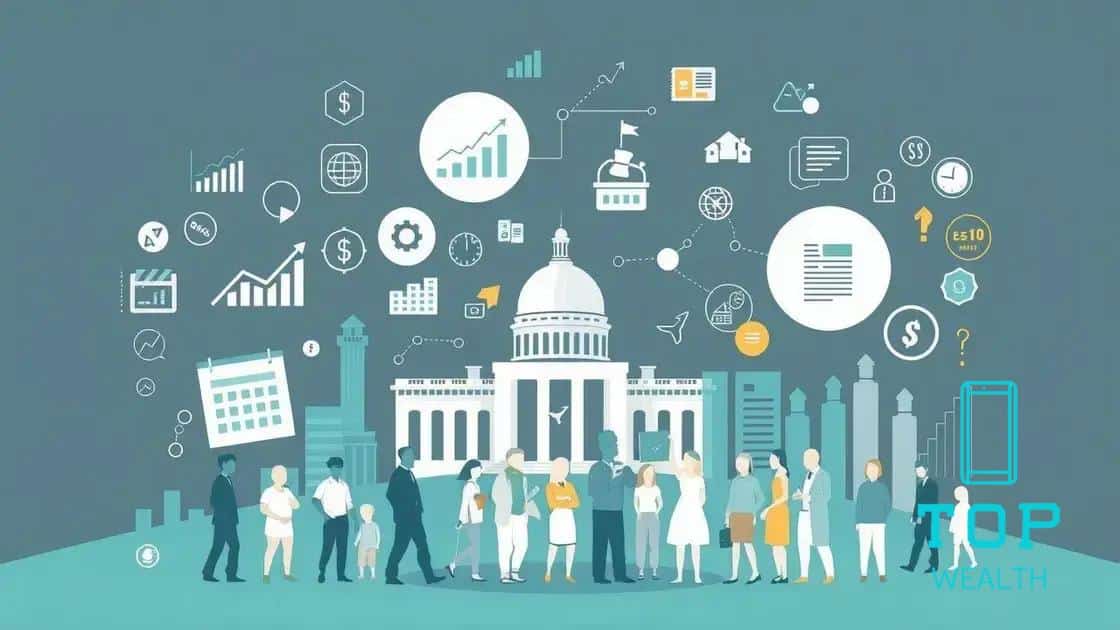Variability in state benefit programs grows: What to know

Variability in state benefit programs grows due to economic conditions, policy decisions, and regional disparities, significantly impacting accessibility and the level of assistance available to individuals across different states.
Variability in state benefit programs grows, and it’s more relevant than ever. Have you noticed how different states offer varying benefits? This discussion dives into the nuances of these programs and their effects on people’s lives.
Understanding state benefit programs
Understanding state benefit programs can be daunting, but it is essential for navigating the support they provide. Each state has its own approach, resulting in varied programs that meet local needs. Whether you’re seeking unemployment benefits, welfare, or food assistance, knowing how these programs work is crucial.
State benefit programs are designed to help individuals and families in need. They can vary significantly based on the state you’re in, affecting everything from eligibility to the amount of assistance provided.
Simplifying State Benefit Programs
Many people find state benefits confusing. Here’s a brief overview of what you might encounter:
- Eligibility Requirements: Each state defines who qualifies for benefits.
- Types of Assistance: Assistance can include cash payments, food stamps, housing support, and more.
- Application Process: States have different application processes, often requiring extensive documentation.
- Impact of Federal Guidelines: Some programs are influenced by federal regulations, while others are entirely state-managed.
Navigating this landscape feels overwhelming, but understanding the basic structure can help ease some confusion. States often tailor their programs to fit their populations, which means that benefits available elsewhere might not exist in your location. It’s essential to research what’s available in your area and the specific eligibility criteria you need to meet.
Moreover, fluctuations in local economies and political priorities can lead to changes in these programs over time. It’s wise to stay informed about these variations, especially if you rely on state benefits. As we explore these topics further, we’ll look at additional factors influencing the delivery and accessibility of these important programs.
Causes of variability in benefits

The causes of variability in benefits can stem from a variety of factors, impacting how state programs are structured. Understanding these causes helps clarify why certain individuals may receive different levels of assistance.
Economic conditions play a significant role in shaping benefit programs. During times of economic hardship, states may expand benefits to support struggling residents. Conversely, in more prosperous times, these benefits may be reduced.
Policy Decisions
State governments influence which benefits are prioritized through their policies. Legislative changes can lead to variations in eligibility and available support. Each state has differing policies that reflect its values and priorities.
- Funding Levels: The amount of funds allocated to programs can vary significantly.
- Political Climate: The ruling party may push for either expansion or reduction in benefits.
- Public Opinion: Citizen feedback can lead to adjustments in available assistance.
Alongside economic and policy factors, demographic shifts can influence benefit variability too. States may adjust programs based on changes in population needs, age distribution, and income levels within communities.
Social issues such as unemployment rates and housing instability also drive changes in state benefits. For example, regions with high unemployment may see temporary increases in unemployment benefits to assist affected workers. Understanding these complex interactions provides deeper insight into the nature of state benefit programs.
How state benefits affect eligibility
State benefits play a crucial role in determining eligibility for various assistance programs. Understanding how these benefits affect eligibility can help individuals navigate their options better.
Generally, eligibility depends on factors such as income, family size, and specific needs. Each state has its own guidelines, which can lead to significant differences in available benefits.
Income Requirements
One major factor influencing eligibility is income. Many programs set a limit on how much a person can earn. If your income exceeds that limit, you may not qualify for certain benefits. Here are key considerations:
- Gross Income: This is the total income before any deductions.
- Net Income: This is your income after deductions, which may allow for certain expenses.
- Income Caps: Different programs have varying income caps based on family size and local cost of living.
Aside from income, family composition significantly impacts eligibility. Programs often require information about household members, including their ages, relationships, and incomes. For example, benefits aimed at families might offer more assistance if there are children, whereas single individuals might face stricter limits.
Your unique circumstances, such as disability or age, can also affect your access to state benefits. Certain benefits, like disability insurance, have specific eligibility requirements that can help those with disabilities receive necessary support.
Understanding these aspects is essential for navigating the complex maze of state assistance. Each state’s criteria can vary widely, creating a patchwork of accessible options for those in need.
Regional disparities in program availability
Regional disparities in program availability can create significant differences in how benefits are accessed across states. These differences shape the experiences of residents seeking assistance.
One of the primary reasons for these disparities is the economic landscape of each state. Wealthier states may have more resources to allocate toward benefit programs, while those with economic challenges might cut back on services.
Factors Influencing Disparities
Several factors contribute to the regional differences in program availability:
- State Budgets: Each state has its fiscal priorities, affecting funding for benefit programs.
- Population Density: Urban areas might have more robust resources to support various programs compared to rural areas.
- Political Commitment: States governed by different political ideologies prioritize assistance programs differently.
Moreover, cultural attitudes towards welfare can also create disparities. States with a stronger belief in governmental support may offer more comprehensive benefits than those where independent self-sufficiency is emphasized.
Accessibility of programs can vary greatly even within the same state. For instance, urban residents may find numerous services nearby, while rural residents could struggle to access the same resources. Geographic barriers often limit the reach of state programs, hindering individuals in remote areas from receiving the help they need.
Understanding these regional differences is vital for recognizing the challenges faced by individuals depending on state assistance. Every state’s approach to benefits reflects a complex mix of economic, political, and societal influences.
Future trends in state benefit programs
The future trends in state benefit programs are shaped by numerous factors, reflecting the changing needs of communities. As economies evolve and populations grow, states are adjusting their programs to meet these new challenges.
One significant trend is the shift towards digital accessibility. Many states are moving their application processes online, making it easier for individuals to access benefits. This change allows for quicker processing and fewer barriers for applicants.
Sustainability and Funding
Sustainability will also be a focal point for future programs. States are working to ensure that funding for benefits can support growing populations without overwhelming budgets. Here are some key aspects of this trend:
- Public-Private Partnerships: Collaborations between state agencies and private organizations may enhance funding and service delivery.
- Innovative Funding Sources: States are exploring alternative funding mechanisms, such as grants and community-driven initiatives.
- Focus on Long-Term Solutions: Programs are evolving to address not just immediate needs but also long-term challenges, like employment and housing stability.
Another essential trend is increasing awareness and integration of mental health services into benefit programs. Recognizing the mental health needs associated with financial instability, states are beginning to include support for mental health as part of their assistance strategies. This holistic approach aims to improve overall well-being and restore individuals to self-sufficiency.
Data-driven decision-making is becoming increasingly vital, allowing states to analyze results and tailor programs to better meet the needs of their populations. Using analytics can lead to smarter policies, ensuring that resources are allocated effectively to where they are most needed.
As these trends continue, the landscape of state benefit programs will remain dynamic, requiring ongoing attention and adaptation. Understanding these shifts helps individuals grasp how assistance could change in the future.
In conclusion, understanding the variability in state benefit programs is essential for effectively navigating assistance. Each program is shaped by economic conditions, policy decisions, and regional disparities, impacting accessibility. As states move towards digital solutions and increased integration of mental health, the future of these programs looks promising. Staying informed about these trends allows individuals to maximize their benefits and ensure they receive the support they need.
FAQ – Frequently Asked Questions about Variability in State Benefit Programs
What factors influence the variability in state benefit programs?
Variability can result from economic conditions, policy decisions, and regional disparities impacting funding and access.
How do digital solutions improve access to state benefits?
Digital solutions streamline application processes, making it faster and easier for individuals to access needed assistance.
Are mental health services integrated into state benefit programs?
Yes, many states are beginning to include mental health support within their benefit programs to address overall well-being.
How can residents stay informed about changes in benefit programs?
Residents can stay informed by visiting state agency websites, engaging with local community organizations, and following governmental updates.





